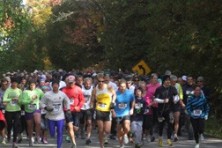Running for the Health of It
- Share
- Tweet
- Pin
- Share
Strengthen your mind through running
Brian Stephens doesn’t just talk the talk when it comes to leading an active lifestyle. He walks the walk. Or, in this case, he runs the run.
On Saturday, May 7, Stephens will join 1,277 fellow runners at the starting line of the Door County Half Marathon. And though he does not claim to be a hard-core distance runner, he has competed in the half marathon almost every year since it started in 2008.
“I did one full marathon back in 2001, but I wasn’t a consistent runner until we moved to Door County in 2005,” he said. “It’s just such a beautiful place to run.”
In addition to the surrounding postcard-worthy scenery, Stephens said he seeks out running not just for the physical-health benefits, but for the mental-wellness perks as well.
“For me, running gives me the time and the space to think and just enjoy nature,” he said. “Whether it’s running or walking, just getting out and being in nature really helps with keeping things organized and in perspective.”

The mental-health benefits of running have long been documented, but a recent study revealed that even as few as 10 minutes of moderate-intensity running gives both your mood and your executive functions a boost. In fact, some researchers are even going so far as to say that running may provide more mental-health benefits than any other type of exercise.
Brady Nieman of Sturgeon Bay would agree.
“There are a lot of physical-health benefits that come with running, but for me it’s always been about mental health,” he said.
After being in an on-again, off-again relationship with running, Nieman went out for a run on Nov. 11, 2020, and never looked back.
“That’s my sobriety date,” said Nieman, who turned to running after hitting his “rock bottom” in a lengthy battle with depression, anxiety and addiction. “I used running to help fight my addiction to alcohol and self-medication. I needed a way out.”
Running became his reason to get up in the morning – to try again, no matter what had happened the day before. It became a way to cope with the everyday stressors in life.
“It’s been incredibly liberating for me,” he said. “It’s given me the confidence and a way to crawl out of the hole I was in.”
But it wasn’t a quick fix.
“It is not an instant thing,” Nieman said. “But it is something you can put your mind to and accomplish over time.”
For him, that meant focusing on just the next step.
“That next step was my instant gratification,” he said. “It was knowing that tomorrow everything won’t be fixed, but the steps I am taking now will help me a year from now.”
Since that first run in November 2020, Nieman has joined the racing scene, starting with the Jacksonport Lake to Lake 10K and then branching out to longer distances such as the Door County Half Marathon, which he will run again this year. All of those miles along the way have helped to build the person Nieman is today.
“It’s been a transformation, and I enjoy that it’s still happening – that I’m still a work in progress,” he said. “I haven’t fixed everything, but I can take what I’ve learned [through running] and apply it to everything in my life. I’ve become a better worker, a better friend, a better partner, a better family member – just from running and exercising.”
But a person doesn’t have to be looking for a transformational experience to reap the benefits of running. Even someone who’s looking for the smallest boost in mood can benefit from going for a run – making the timing of the Door County Half Marathon particularly advantageous for those who experience seasonal affective disorder (SAD) or just tend to feel more sluggish during the winter.
The motivation that training for a half marathon provides is another reason why Stephens is drawn to it every year.
“I like that it is in the spring because it keeps me on a training plan and active throughout the winter months,” said Stephens, who sticks to a training routine that includes four days of running and one long run per week.
Spending time outside during daylight hours is one of the best ways to combat the effects of SAD, but even if the shortened days or inclement weather keep you running indoors, your mood and mental well-being still benefit from the endorphins released while running.
Mental-health benefits aside, an article from Johns Hopkins Medicine said that “regular cardiovascular exercise can spark growth of new blood vessels to nourish the brain. Exercise may also produce new brain cells in certain locations through a process called neurogenesis, which may lead to an overall improvement in brain performance and prevent cognitive decline.”
That’s good news for people who are looking for ways to improve their overall health. But where to start?
“I would encourage people to just start running – even just a little bit,” Nieman said. “Go out for 20 minutes, whether it’s a run, a walk, whatever you can do.”
From there, set small, achievable goals.
“It’s so easy to set goals with running,” he said. “You can go for distance – I’m going to go for a 5K, or I’m going to go for a 10K – or you can go for consistency – I’m going to run for five days instead of four days. It’s all an accomplishment.”
The body may be sore afterward, but Nieman promises the mind will feel renewed.




